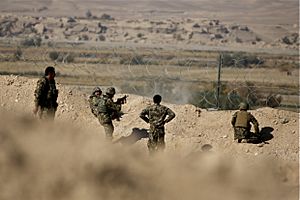Taliban insurgency facts for kids
The Taliban insurgency was a long conflict in Afghanistan. It started after the Taliban group lost power in 2001. The Taliban fought against the Afghan government and its allies. These allies included forces from the United States and NATO countries.
The Taliban wanted to regain control of Afghanistan. They fought against the Afghan national army and police. They also targeted regular people. Some groups, like the Haqqani Network, joined the Taliban in this fight. The conflict also affected parts of neighboring Pakistan.
On August 15, 2021, the Taliban took control of Kabul, Afghanistan's capital. This led to the end of the Afghan government at that time.
Why the Taliban Insurgency Started
After the United States invasion of Afghanistan in 2001, the Taliban were defeated. Many of their fighters either left or went into hiding. Some found safety in Pakistan.
By 2003, high-ranking Taliban leaders said they were ready to fight again. They planned a guerrilla war. This is a type of fighting where small groups use surprise attacks. Their goal was to make US forces leave Afghanistan.
In 2004, the Taliban leader, Mohammed Omar, announced their new fight. He said they were fighting against "America and its puppets." This meant the Afghan government that was supported by the US. They wanted to "regain the sovereignty of our country." This means they wanted Afghanistan to be fully independent and ruled by them.
The Taliban spent several years getting stronger. They started to fight more actively in 2006. This marked a big increase in the insurgency.
How the Taliban Was Organized
As of 2018, the Taliban had several main groups or councils. These councils are called shuras. A shura is like a leadership council.
The main shura was the Quetta Shura. It was the most important one. Two smaller shuras worked under it. These were the Haqqani network and the Peshawar Shura. The Haqqani network is also known as the Miran Shah Shura.
The Peshawar Shura was formed in 2005. It was based in eastern Afghanistan. Many of its fighters used to be part of another group called Hezb-e Islami Gulbuddin. The Haqqani network became independent for a while in 2007. But it rejoined the Quetta Shura in 2015. The Peshawar Shura was also independent from 2009 to 2016.
There were other important shuras too. The Shura of the North was based in Badakhshan Province. The Mashhad Shura was supported by Iran. There was also the Rasool Shura, led by Muhammad Rasul. It was also known as the High Council of the Islamic Emirate.
What Happened After the Insurgency
When the Taliban insurgency ended, a new situation began. The Taliban took control and formed the Islamic Emirate of Afghanistan.
However, some groups did not agree with the Taliban's rule. They started a new fight against the Taliban. This new fight is called the Republican insurgency. Groups like the National Resistance Front are part of this new conflict. They fight under the flag of the former Islamic Republic of Afghanistan.


